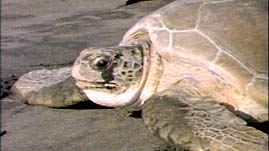Sea turtles are large, long-lived, air-breathing reptiles that spend all but a short period of their lives in the open ocean. The stout-bodied, primitive appearance of these creatures suggests an early and long evolutionary history. Indeed, scientists who study the fossil record have found remains of sea turtles, nearly identical to those that exist today, in sediments laid down 150 million years ago. They conclude that sea turtles were swimming the oceans long before the last of the dinosaurs became extinct.
Unfortunately, while sea turtles have spent millions of years apparently perfectly adapted to undisturbed beaches and nutrient-rich ocean waters, they are far less prepared for a world teeming with human activity. Today, every one of the seven species of sea turtles that exist worldwide is listed by international conservation agencies as threatened or in danger of becoming extinct.
One of the main reasons for the collapse of sea turtle populations over the last 50 years is that the animals require two environments highly prized by humans: beaches and coastal waters. Sea turtle eggs incubate buried in the sand, and so each year females crawl ashore to lay their eggs in an area of the beach high enough that the eggs won't be flooded. Most females nest at least twice in a given breeding season; some may nest up to 10 times in a season. A female, however, will not nest in consecutive years, typically skipping one or two years before returning to the same beach. But when she does return, it's often within a few hundred yards of where she laid her eggs previously. Commercial development along these traditional nesting zones has dramatically decreased the amount of beach available to sea turtles. Beaches have eroded or become too compact for turtles to lay eggs. In addition, artificial lights along beaches deter females from laying eggs or disorient hatchlings attempting to make their way to the water.
Perhaps just as important to the decline of sea turtles is the impact humans have at sea. Sea turtles spend the majority of their lives in the open ocean, typically not very far offshore, where they feed on a variety of mollusks, crustaceans, jellyfish, and sea plants. Their close proximity to shore, however, puts turtles at risk of being hunted for their meat and shells or getting caught accidentally in fishing nets and drowning. Many turtles also die from ingesting garbage, like plastic bags, that they may mistake for food. Unfortunately, very little is known about the habits and habitats of turtles when they're at sea. With recent advances in radio-tracking technology, researchers hope to learn more about the threats to sea turtles, so that they can conserve and expand the populations that are left.

 Loading Standards
Loading Standards Teachers' Domain is proud to be a Pathways portal to the National Science Digital Library.
Teachers' Domain is proud to be a Pathways portal to the National Science Digital Library.
